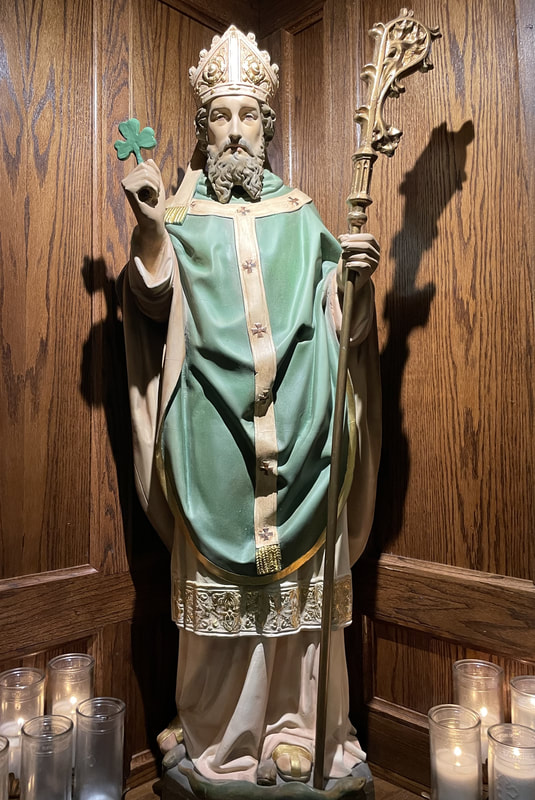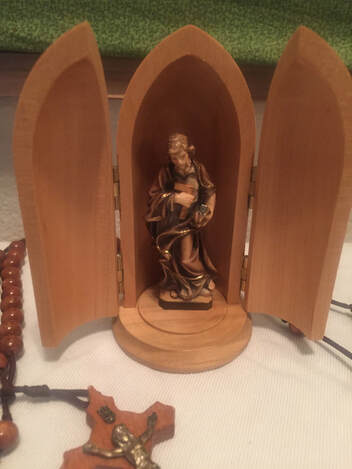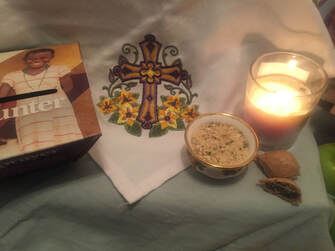|
* first published on 3/26/2022 at www.catholic365.com
If you happened to catch a bit of the televised interview of Ukrainian President Zelensky, given just days after the invasion of Russia, you may have heard him say something to this effect: Interviewer: President Zelensky, is this effort for freedom worth it? President Zelensky: I hope the western countries have seen and understand just how important freedom is to the Ukrainian people. We are not just talking about it, we are giving our lives for it. It was a moving and grave moment, asking those of us in the west to think more seriously about this thing we call "freedom," and indeed, ask ourselves just what we would be willing to sacrifice to defend it. So what is "Freedom" anyway? I asked this very question to a group of parishioners just a couple of weeks ago. We had just finished watching the first episode of "The Quest", a 5 part documentary-style video series produced by the University of Dallas, and we were discussing it. "Freedom is the ability to choose, " one fellow answered. "Freedom is being able to make your own decisions and live how you want," another parishioner said, "so long as it doesn't hurt anyone." "Yes," agreed a third person, "Freedom means doing what you think is right." The answers the parishioners gave, who were of all different ages, by the way, pretty much aligned with the general understanding of "freedom" today. The problem is, that is not what true freedom actually is. It's certainly not the freedom Jesus promised, the freedom that "sets us free from sin." To Christians, freedom is the ability to choose and then move towards the good. Since we know that our Ultimate Good is God, true freedom really refers to our continuing conversion, that process by which we repeatedly, frequently and usually in small, hidden ways, overcome our own selfishness and become self-sacrificing. True freedom is desiring what God desires, and them moving towards it. In "Commentary on the Sentences," St. Thomas Aquinas puts it this way: freedom “is by its nature ordered to the good, and tends to evil only by defect.” (II Set., Dist. 25, Q. 1, A. 1, Ad. 2).Freedom is not the path to a life of luxury, comfort, and release from responsibilities so that we can manifest our own destinies. Instead, it is the path to becoming little Christs, the path which ultimately leads us home to our Father's house. During the month of March, we celebrated two feast days of important saints who give us wonderful examples of lives lived in freedom. On March 17, we recall the life and work of St. Patrick of Ireland and then just two days later on March 19, we celebrate the Solemnity of St. Joseph. Both of these saints exemplify true freedom. We know that St. Patrick was kidnapped into slavery as a teen and endured several years of isolation, neglect and abuse. He miraculously escaped, and was able to rejoin his family again. Yet later, upon having a vision in which the Irish asked him to return and "walk among them once more" St. Patrick writes his "heart was broken" with pity. He eventually returns to Ireland, where he is a great evangelist. The life of this saint reveals the actions of a man who is truly free. He would rather die, giving his life in the service of God, than remain in safety and comfort. He returns to the very place of his captivity in order to save others. Similarly, the actions of St. Joseph reveal he is free. Every event of his life recorded in Scripture shows St. Joseph consistently choosing the Ultimate Good, God, regardless of the difficulties involved. For example, upon discovering that Mary is pregnant, he seeks to "divorce her quietly', minimizing any embarrassment, or worse, punishment, to her. Next, after being told in a dream that the child Mary is carrying is God's child, Joseph immediately brings Mary into his house, again seeking to do the will of God despite being hard, even illogical. Then, he again immediately responds to the urgent command to take his small family and flee to Egypt, away from any support they may have, into a foreign country, trusting that God will protect and provide for them. Joseph could have turned from the path God laid out for him. Each request was difficult and a challenge, but he consistently chooses the good, he consistently desires what God desires, and he moves toward it. As we continue in our Lenten journey to the Paschal Mystery, we should also ask ourselves: when do I live in freedom? And where am I still bound by sin, unable to follow the call of the Lord? St. Patrick, pray for us! St. Joseph, pray for us!
0 Comments
Although we are used to seeing lots of shamrocks and assorted green things in honor of St. Patrick during the month of March, there’s another special day in this month we should keep in mind as well. March 19 is the Solemnity of St. Joseph, spouse of the Blessed Virgin Mary. In many parts of the world, this is a big feast day, marked by special foods and by setting up a St. Joseph’s Altar. This day is remembered especially as a day to thank God for the intercession of St. Joseph.
The tradition of setting up an altar honoring St. Joseph began in Sicily, Italy, and was brought to the United States by Italian immigrants in the late 1880s. As the story goes, a severe famine hit Sicily in the Middle Ages (likely causing one of the “megafamines” Europe suffered) and the crops were in danger of failing. The farmers and families prayed to St. Joseph for his help, and were filled with gratitude when the rains came. They attributed the help to their patron saint, and at harvest time erected a large altar in his honor. On the altar they placed fruits, veggies, baked goods and lots of fava beans – the beans that had sustained them during the lean months until harvest. In recognition of St. Joseph’s humble life, the families invited everyone, especially the poor, to come to the feast. Everyone was invited, and everyone could participate in the abundance. Today, many churches and Italian communities still erect an altar to St. Joseph, and over time specific foods have become traditional to place on the altar. The custom of remembering the poor has also become an aspect of the altar. Many of the altars are elaborate and the foods can be quite involved to make, but don’t let that stop you from setting up an altar in your own home! We are aiming for participation, not perfection. With a few adaptations, every family can join in the celebration. Below, you can see the altar I set up in our house. A quick trip to the grocery store, plus a tour around my house for plates and linens, and I was done. I used our Family Prayer Space to set it all up. There are just a few things to keep in mind in when setting up a St. Joseph’s Altar. Below are close – up pictures and an explanation of how we did it. 1. Give Our Best: In keeping with all things sacred, we always try to give our best. That means I got out the nice china and Easter linens to use. There’s no need to buy anything “good,” of course, but this is a great time to get out those fancy items usually tucked away for “one day.” That day has come! 2. Showcase the Trinity: The altar should be 3 levels. This is a physical representation of the Trinity, who listened to the intercession of St. Joseph and came to the aid of the farmers. It reminds us that the saints are fully united to the Trinity, and always carry out the best for us. It also reminds us that the Trinity is under and behind everything, even though we only see the people and things on the top, the surface level. 3. Honor St. Joseph: Place a statue of St. Joseph on the top level. After all, this is his day. The folks at Holyart.com sent me this lovely statue of St. Joseph to preview. It features St. Joseph, with his carpentry tools, inside a wooden niche with swinging, hinged doors. I had this statue sitting out on my kitchen bench and 2 of my boys picked it up. They were fascinated with the doors and St. Joseph hidden inside, and it led to a great conversation about St Joseph’s “hidden” life, and how little is recorded of him. Yet, in spite of this, what an enormous role he played in the life of Christ and salvation history. The statue proved to be a wonderful conversation starter about what it means to be a man of God. - The statue is handcarved by Italian woodworkers from a company called Pema. (Pema.it). My boys loved the idea that woodworkers today made this image of St. Joseph, also a woodworker. It made St. Joseph seem more real, like there was a connection to him through the work of hands. They looked at the tools St. Joseph is holding – a square and a plane- and thought about how those same tools created the statue they were holding. - This particular statue is a bit more expensive than I would normally spend on a statue, but the detailing and high quality craftsmanship make it worthwhile. This is a holy item that I can keep as a family keepsake, and perhaps even see it in use on St. Joseph altars in future generations. (though not for a while!)
4. The Food! There are some food items that are almost always seen on St. Joseph altars.
Fruits and Veggies: Put an assortment of veggies and fruits on your altar. I used what I had in my fridge. Pastries: As I mentioned above, some of the baked good items are traditional. A delicious cream filled pastry called a zeppole features prominently. It looks amazing, but I am not that mom. I hope to be that grandmother. Instead of baking these myself, I went to the bakery at my grocery store and bought a few individual cream themed pastries. Another traditional cookie for the altar is called a pizzelle. It is created using a special type of waffle iron. Again, I picked up a container of these at the grocery store in the cookie aisle. I also added some mini cupcakes, just for fun. Figs: Figs are plentiful in Italy, and so generally appear on the St. Josephs altar. I do not like to waste food, even for these teaching moments, so instead of the fruit I bought a couple of types of Fig Newton – like cookies.
Bread Crumbs: These symbolize the sawdust found in St. Joseph’s workroom. I used the Italian seasoned breadcrumbs, of course.
Wine: a bottle of red wine is appropriate, as a reminder of the joy and happiness of the occasion. It’s also a good reminder of the red wine used at Mass, and Jesus’ first miracle at the wedding at Cana, which took place at another festival as well. Bread: some nice bread is also usually on the atlar. I picked up a tasty assortment of bread rolls at the bakery. Beans: Fava beans were originally used on the altar, and are still widely used today. However, I substituted them for great northern beans, as they were not available at my grocery store. 5. What else? Candles: Especially a candle of the Sacred Heart, if you have it, reminding us of St. Joseph’s years of caring for Jesus. A rosary: because after all, this commemorates an answer to prayer and Mary is always close to Joseph. Crosses: I placed a couple of small crosses on our altar, to remind us that it is through the sacrifice of our Lord that we receive the blessings of God. A CRS Rice Bowl: we also want to remember that the story of the altar emphasizes that the graces and abundance of God are to be shared with everyone. Since my parish participates in the CRS Rice Bowl during Lent, I added it to our altar as a reminder to include the poor in this celebration.
Once everything was all set, we held our own Prayer Service. (see below to download our Family Prayer Service)
All told, my grocery bill came to $20.26 to create our St. Joseph Altar. As I said, I used mostly what I had in the house already, which I think is a fitting tribute to the life of the Holy Family, anyway. Remember, participation, not perfection! My kids, having never experienced a St. Joseph’s altar before, absolutely loved it. It was a fantastic way to remind ourselves of the the life of St. Joseph, learn more about another culture, participate in the liturgical calendar, and of course, enjoy some really yummy treats. I think this is destined to become a new family tradition.
|
The BlogDisclaimer:
The images on this website are either my own or are used under the Creative Commons license. No images have been edited, shared, or adapted. A link to each work that I do not own is provided at the bottom of the page. CC License: Archives
March 2024
Categories
All
|
||||||











 RSS Feed
RSS Feed
